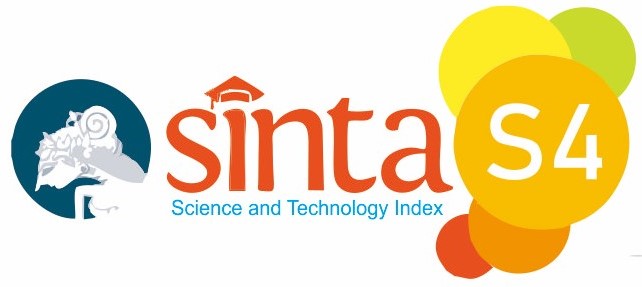Analysis of the Influence of Turbulent Models in CFD Simulation of Centrifugal Fans using Ansys
Abstract
The study was conducted to determine the airflow in the backward type centrifugal fan using Computational Fluid Dynamics (CFD) simulation. This type of fan is often used in various industries due to its high efficiency in moving air or gas. In CFD simulation, the selection of the right turbulent model is very important to obtain simulation results that are reliable, efficient, and relevant to real conditions. The study used four different turbulent models to look at their effects on pressure distribution, flow velocity, and fan efficiency. The turbulent models used are k-ε Standard, k-ε RNG, k-ε Realizable and k-ω SST. The goal was to find the most optimal turbulent model of the centrifugal fan around the impeller. The impeller has an angle (,β-1.) of 35,260 with a rotation speed of 301,069 rad/s. The simulation was carried out by meshing about 500,000 mesh elements for a balance between accuracy and computing needs. Validation was carried out by comparing the simulation results of Ansys Student R1 2024 and Solidwork. Of the four turbulent models tested, k-ε RNG provided the most accurate results, with an efficiency difference of only 1.3% compared to Solidworks. This model manages to capture better variations in pressure and flow velocity, especially in turbulent areas and around the impeller. These results show that the k-ε RNG turbulent model provides closer results than other models. These findings are important for the optimization of centrifugal fan design and emphasize the importance of selecting the right turbulent model in numerical simulations.
References
Cory, W. T. W. . (2006). Fans and ventilation : a practical guide. (Contains a substantial buyers guide/directory also). Elsevier Advanced Technology.
Dewangga, M., & Yamin, M. (2021). M U H A M M A D I Y A H J A K A R T A RANCANG ULANG DESAIN IMPELLER KIPAS SENTRIFUGAL SISTEM PENDINGIN MESIN SEPEDA MOTOR SKUTIK DENGAN METODE REVERSE ENGINEERING. 13(1). https://doi.org/10.24853/jurtek.13.1.63-74
Eskandari, H., Nik, M. G., & Pakzad, A. (2016). Foundation analyzing of centrifugal ID fans in cement pla nts. Alexandria Engineering Journal, 55(2), 1563–1572. https://doi.org/10.1016/j.aej.2016.04.011
Fatahian, H., Mishra, R., Jackson, F. F., & Fatahian, E. (2023). Design optimization of an innovative deflector with bleed jets to enhance the performance of dual Savonius turbines using CFD-Taguchi method. Energy Conversion and Management, 296, 117655. https://doi.org/10.1016/j.enconman.2023.117655
Huang, C. K., & Hsieh, M. E. (2009). Performance analysis and optimized design of Backward-Curved airfoil centrifugal blowers. HVAC and R Research, 15(3), 461–488. https://doi.org/10.1080/10789669.2009.10390846
Iskandar, Y., Nazaruddin, N., & Arif, Z. (2021). PENGARUH JUMLAH SUDU IMPELLER TERHADAP DEBIT AIR YANG DIHASILKAN POMPA CENTRIFUGAL. JOURNAL OF MECHANICAL ENGINEERING MANUFACTURES MATERIALS AND ENERGY, 5(1), 78–90. https://doi.org/10.31289/jmemme.v5i1.4472
Kaul, R. (2016). International Journal of Current Engineering and Technology CFD Analysis of Centrifugal Pump’s Impeller of Various Designs and Comparison of Numerical Results for Various Models. http://inpressco.com/category/ijcet
Li, H., Chen, Y., Yang, Y., Wang, S., Bai, L., & Zhou, L. (2023). CFD Simulation of Centrifugal Pump with Different Impeller Blade Trailing Edges. Journal of Marine Science and Engineering, 11(2). https://doi.org/10.3390/jmse11020402
Mahmoodi-Eshkaftaki, M., & Ebrahimi, R. (2019). The effect of blade angle of turbine impellers on anaerobic digestion efficiency in stirred digesters. Energy, 178, 772–780. https://doi.org/10.1016/j.energy.2019.04.183
Moon, H., Jeong, J., Park, S., Ha, K., & Jeong, J. H. (2023). Numerical and experimental validation of vortex generator effect on power performance improvement in MW-class wind turbine blade. Renewable Energy, 212, 443–454. https://doi.org/10.1016/j.renene.2023.04.104
Patel, J. I., Makadia Engineering, R. N., & Student, P. G. (2014). 73 X PARIPEX-INDIAN JOURNAL OF RESEARCH A Review on Performance of Industrial Induced Draft Centrifugal Fan Using Ansys Cfx. 1.
Salmat, S., Yanti Sari, D., Fernanda, Y., & Prasetya, F. (2023). SolidWorks Flow Simulation: Selecting the optimal mesh for conducting CFD analysis on a centrifugal fan. Journal of Engineering Researcher and Lecturer, 2(3), 94–103. https://doi.org/10.58712/jerel.v2i3.104
Sinaga, N., Efisiensi, L., & Energi, K. (2010). PENGARUH MODEL TURBULENSI DAN PRESSURE-VELOCITY COPLING TERHADAP HASIL SIMULASI ALIRAN MELALUI KATUP ISAP RUANG BAKAR MOTOR BAKAR (Vol. 12, Issue 2).
Umurani, K., Rahmatullah, R., & Rachman, F. A. (2020). Analisa Pengaruh Diameter Impeller Terhadap Kapasitas Dan Penurunan Tekanan Blower Sentrifugal. Jurnal Rekayasa Material, Manufaktur Dan Energi, 3(1), 48–56. https://doi.org/10.30596/rmme.v3i1.4528
Varun Ch, S., Anantharaman, K., & Rajasekaran, G. (2023). Effect of blade number on the performance of centrifugal fan. Materials Today: Proceedings, 72, 1143–1152. https://doi.org/10.1016/j.matpr.2022.09.185
Versteeg, H. K., & Malalasekera, W. (2007). An Introduction to Computational Fluid Dynamics Second Edition (Second). www.pearsoned.co.uk/versteeg
Zhao, X., Li, H., Yang, S., Fan, Z., Dong, J., & Cao, H. (2021). Blade vibration measurement and numerical analysis of a mistuned industrial impeller in a single-stage centrifugal compressor. Journal of Sound and Vibration, 501. https://doi.org/10.1016/j.jsv.2021.116068
Submitted
Copyright (c) 2025 Jurnal Vokasi Mekanika

This work is licensed under a Creative Commons Attribution 4.0 International License.








.svg_.png)


